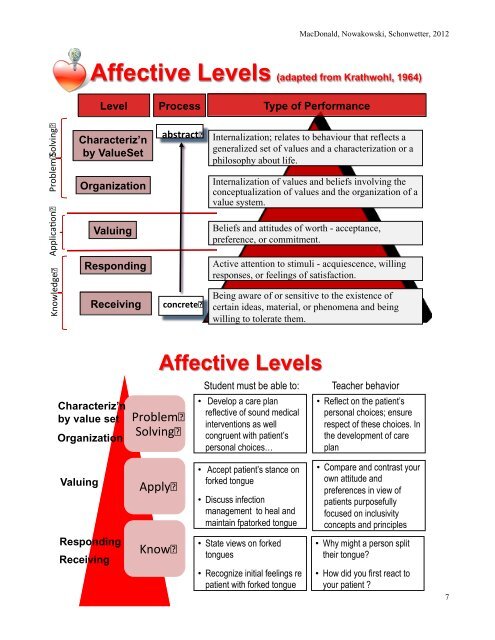Actively Engaging Students in Affective, Cognitive, & Psychomotor ...
Actively Engaging Students in Affective, Cognitive, & Psychomotor ...
Actively Engaging Students in Affective, Cognitive, & Psychomotor ...
Create successful ePaper yourself
Turn your PDF publications into a flip-book with our unique Google optimized e-Paper software.
Knowledge Applica on Problem Solv<strong>in</strong>g<br />
MacDonald, Nowakowski, Schonwetter, 2012<br />
<strong>Affective</strong> Levels (adapted from Krathwohl, 1964)<br />
Level Process<br />
Type of Performance<br />
Characteriz’n<br />
by ValueSet<br />
Organization<br />
Valu<strong>in</strong>g<br />
Respond<strong>in</strong>g<br />
Receiv<strong>in</strong>g<br />
Characteriz’n<br />
by value set<br />
Organization<br />
Valu<strong>in</strong>g<br />
Respond<strong>in</strong>g<br />
Receiv<strong>in</strong>g<br />
Problem<br />
Solv<strong>in</strong>g<br />
Apply<br />
Know<br />
abstract<br />
concrete<br />
Internalization; relates to behaviour that reflects a<br />
generalized set of values and a characterization or a<br />
philosophy about life.<br />
Internalization of values and beliefs <strong>in</strong>volv<strong>in</strong>g the<br />
conceptualization of values and the organization of a<br />
value system.<br />
Beliefs and attitudes of worth - acceptance,<br />
preference, or commitment.<br />
Active attention to stimuli - acquiescence, will<strong>in</strong>g<br />
responses, or feel<strong>in</strong>gs of satisfaction.<br />
Be<strong>in</strong>g aware of or sensitive to the existence of<br />
certa<strong>in</strong> ideas, material, or phenomena and be<strong>in</strong>g<br />
will<strong>in</strong>g to tolerate them.<br />
<strong>Affective</strong> Levels<br />
Student must be able to: Teacher behavior<br />
• Develop a care plan<br />
reflective of sound medical<br />
<strong>in</strong>terventions as well<br />
congruent with patient’s<br />
personal choices…<br />
• Accept patient’s stance on<br />
forked tongue<br />
• Discuss <strong>in</strong>fection<br />
management to heal and<br />
ma<strong>in</strong>ta<strong>in</strong> fpatorked tongue<br />
• State views on forked<br />
tongues<br />
• Recognize <strong>in</strong>itial feel<strong>in</strong>gs re<br />
patient with forked tongue<br />
• Reflect on the patient’s<br />
personal choices; ensure<br />
respect of these choices. In<br />
the development of care<br />
plan<br />
• Compare and contrast your<br />
own attitude and<br />
preferences <strong>in</strong> view of<br />
patients purposefully<br />
focused on <strong>in</strong>clusivity<br />
concepts and pr<strong>in</strong>ciples<br />
• Why might a person split<br />
their tongue?<br />
• How did you first react to<br />
your patient ?<br />
7



